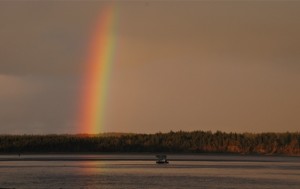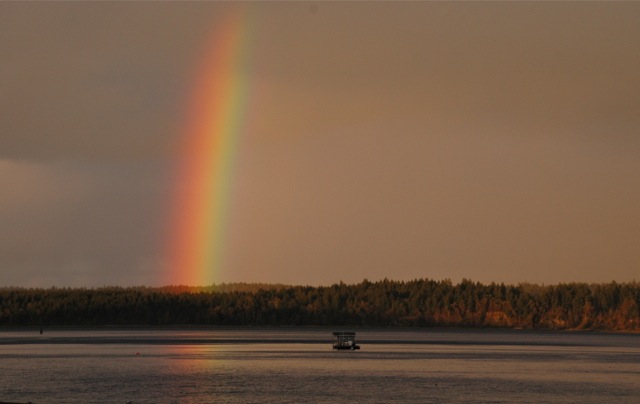Submitted by Capitol Land Trust
Public invited to community celebration June 3 to tour parcel and honor partners
 With the help of many partners and financial supporters, Capitol Land Trust purchased the former Bayshore Golf Course and surrounding coastal wetlands on Oakland Bay in Mason County. Seventy-four acres, with more than 4,000 feet of marine shoreline and 27 acre of intact, saltmarsh habitat, are now conserved—forever.
With the help of many partners and financial supporters, Capitol Land Trust purchased the former Bayshore Golf Course and surrounding coastal wetlands on Oakland Bay in Mason County. Seventy-four acres, with more than 4,000 feet of marine shoreline and 27 acre of intact, saltmarsh habitat, are now conserved—forever.
Much of north Oakland Bay, including the “Bayshore” (Johns Creek estuary) marine shoreline was mapped among the highest habitat values in the South Puget Sound—in a Washington State Department of Fish and Wildlife assessment—placing it on par with the Nisqually Delta and the Kennedy Creek estuary. The listing was part of the Puget Sound Watershed Characterization Project, a 2013 assessment.
Working together to achieve common goals
Completion of this transaction is a milestone that also will forever confirm the value of Capitol Land Trust’s collaborative approach. The Bayshore project builds on the successful partnership between Capitol Land Trust, the Squaxin Island Tribe, Washington State Department of Ecology, US Fish & Wildlife Service, the Salmon Recovery Funding Board, Taylor Shellfish Farms, Mason Conservation District, Mason County, The Trust for Public Land, and others that already have conserved more than 250 acres of Oakland Bay estuarine and coastal habitat on three sites in the immediate vicinity of the Johns Creek estuary.
The project plays a key role in a larger, strategic effort by Capitol Land Trust and the Squaxin Island Tribe to conserve key marine nearshore and freshwater habitats and ecosystem function in the Oakland Bay watershed, as outlined in the Oakland Bay and Hammersley Inlet Nearshore Habitat Assessment (Anchor Environmental) and collaborated by the Oakland Bay Action Plan and in South Puget Sound salmon recovery plans. In response to the Oakland Bay and Hammersley Inlet Nearshore Habitat Assessment, Capitol Land Trust and the Squaxin Island Tribe identified several large Oakland Bay coastal properties as essential conservation priorities. Now, Oakland Bay County Park (Malaney Creek estuary), Twin Rivers Ranch Preserve (Deer Creek and Cranberry Creek estuaries) and as of last month, the Bayshore properties (John’s Creek estuary) are permanently conserved.
Currently, the Oakland Bay area is relatively undeveloped, but that could easily change over the next few decades. Sustaining and restoring the natural function of these strategic sites reduces water pollution and helps to ensure the county’s waters remain safe for swimming, fishing, shellfish farming and all activities important to the culture, heritage and economy of the area.
The mouth of Johns Creek is the site of what was once one of the largest longhouses and Squaxin villages. “We have always thought of this place as special,” said Andy Whitener, Natural Resources Director for the tribe. “Our people lived there for thousands of years, subsisting on the fish, shellfish and wildlife that were always available.”
“The decline of salmon and shellfish directly impacts our culture, economy and our treaty reserved rights,” he continued. “Making sure Oakland Bay is healthy is one of the most important things we can do to protect our way of life.”
The Department of Ecology and Washington Water Trust helped Capitol Land Trust retire the surface water rights associated with the golf course. “With sufficient water in the summer, Johns Creek has the capacity to support healthy runs of coho and summer and fall chum,” said Scott Steltzner, salmon biologist for the Squaxin Island Tribe. “Because Johns Creek currently does not meet minimum low flow standards and new water appropriations are still being granted, securing this water right for use by fish was crucial.”
Capitol Land Trust’s deliberate approach
Capitol Land Trust has systematically identified Oakland Bay’s top conservation priorities; established trusting relationships with landowners; built cooperation and support among dozens of project partners; secured seven million dollars in grant funding; and successfully negotiated agreements that permanently conserve more than three miles of estuarine habitat in upper Oakland Bay. “It is important to make sure we protect places like Oakland Bay, before they turn the corner and can’t be saved,” said Jeff Dickison, Assistant Natural Resources Director for the Squaxin Island Tribe.
Eric Erler, Capitol Land Trust’s outgoing Executive Director says, “This successful purchase is a testament to the dedication and creativity of Conservation Program Manager Laurence Reeves and Capitol Land Trust’s entire staff. As with every complex land transaction, Capitol Land Trust’s success is made possible by the support we receive from our members, donors and from many stakeholders.”
Restoring the site
In the coming years, Capitol Land Trust will partner with the Squaxin Island Tribe and other organizations to remove a 1,400 foot dike, restoring the Johns Creek estuary and important marine shoreline. “Taking the dike out will provide salmon with additional acres of saltwater marsh to use as they migrate out to the ocean,” said Dickison. In addition, eventually the golf course fairways will be replanted with native vegetation, restoring a streamside forest that helps provide cool water and in-stream structural complexity, both important components of high quality salmon habitat.
Join Capitol Land Trust for the Oakland Bay Estuary Conservation Celebration
When: 10:00 AM, June 3, 2014
Where: Bayshore Property – 3800 E State Route 3, Shelton, WA 98584
Join Capitol Land Trust to celebrate this major conservation success, tour the property and recognize project partners at the Bayshore Conservation Celebration. No RSVP necessary, we hope to see you there! Learn more about Capitol Land Trust at CapitolLandTrust.org.
Oakland Bay Estuary Project Partners
– Squaxin Island Tribe
– WA State Department of Ecology
– US Fish and Wildlife Service
– WA Recreation & Conservation Office
– Salmon Recovery Funding Board
– WA State Wildlife & Recreation Program
– US Environmental Protection Agency
– Washington Water Trust
– Shelton-Bayshore Golf Company
– Estuary and Salmon Restoration Program
– The Trust for Public Land
– Mark Peternell – Bean Gentry Wheeler Peternell, PLLC
– Taylor Shellfish Farms
– Mason Conservation District
– CBRE
– Bayshore Inc.
– South Puget Sound Salmon Enhancement Group
– Mason County
– WRIA 14 Lead Entity
– ADESA Environmental Services LLC
– WA State Department of Health
– Puget Sound Partnership



















































